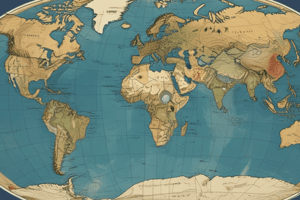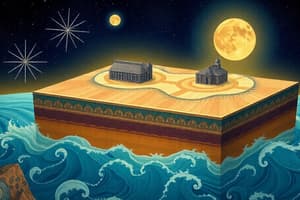Podcast
Questions and Answers
What process contributes to the formation of ocean basins, according to the Wilson Cycle?
What process contributes to the formation of ocean basins, according to the Wilson Cycle?
- The spreading of the seafloor at mid-ocean ridges causing the formation of new ocean crust (correct)
- The subduction of oceanic lithosphere causing the formation of a trench
- The erosion of landmasses by rivers and glaciers causing the formation of sedimentary deposits on the ocean floor
- The collision of two continental plates causing the formation of a mountain range
Which of these is a process that decreases salinity in ocean water?
Which of these is a process that decreases salinity in ocean water?
- Evaporation
- Subduction
- Formation of sea ice
- Runoff (correct)
What is the average age of the ocean floor?
What is the average age of the ocean floor?
- 100 million years
- 1 billion years
- 200 million years (correct)
- 500 million years
Which of the following is associated with a transform boundary?
Which of the following is associated with a transform boundary?
What is the term for a flat-topped seamount that was once a volcano?
What is the term for a flat-topped seamount that was once a volcano?
What is the approximate depth of a typical continental shelf?
What is the approximate depth of a typical continental shelf?
Which of these is NOT a factor that influences the salinity of ocean water?
Which of these is NOT a factor that influences the salinity of ocean water?
What is the name of the process that involves the removal of salt from seawater?
What is the name of the process that involves the removal of salt from seawater?
Flashcards
Chronometer
Chronometer
A device that provides accurate timekeeping to determine longitude.
Ocean Origins
Ocean Origins
Formed from volcanic emissions of water vapor that condensed into clouds and filled Earth's basins.
Alfred Wegener
Alfred Wegener
Proposed the theory of Continental Drift.
Wilson Cycle
Wilson Cycle
Signup and view all the flashcards
Salinity and Density
Salinity and Density
Signup and view all the flashcards
Transform Boundaries
Transform Boundaries
Signup and view all the flashcards
Hydrothermal Vents
Hydrothermal Vents
Signup and view all the flashcards
Desalination
Desalination
Signup and view all the flashcards
Study Notes
Oceanographic Principles
- Chronometer: Used for precise timekeeping, crucial for determining longitude.
- Ocean Origins: Volcanic emissions released water vapor, which condensed and precipitated, forming Earth's oceans.
- Oldest Fossils: 3.5 billion-year-old photosynthetic bacteria are the oldest known fossils.
- Alfred Wegener: Proposed the theory of Continental Drift.
- Harry Hess: Developed the theory of Seafloor Spreading.
- Plate Boundaries:
- Divergent Boundaries: Create mid-ocean ridges (MORs) and rift valleys.
- Convergent Boundaries: Form trenches and volcanic arcs (mountain ranges or islands).
- Ocean-Ocean Convergence: Leads to island arcs, with one oceanic plate subducting beneath another.
- Ocean-Continent Convergence: Creates mountains and volcanic arcs, with oceanic lithosphere subducting beneath a continental plate.
- Continent-Continent Convergence: Results in massive mountain ranges; plates are too buoyant to subduct, leading to crustal thickening and crumpling.
- Transform Boundaries: Generate fault lines.
Ocean Features and Processes
- Guyots: Flat-topped seamounts.
- Satellite Altimetry: Techniques (like Geosat, CryoSat-2, and Jason-1) used to measure ocean surface height.
- Hydrothermal Vents: Located along mid-ocean ridges (MORs).
- Ocean Salinity Variations:
- High Latitudes: Lower salinity due to melting icebergs and precipitation.
- Low Latitudes: Higher salinity due to high evaporation rates.
- Equator: Moderate salinity due to precipitation and evaporation balance.
- Factors Affecting Salinity:
- Decreasing Salinity: Precipitation, runoff, and melting ice.
- Increasing Salinity: Sea ice formation and evaporation.
- Ocean Density: Salinity and temperature influence density; lower temperature means higher density, higher salinity means higher density.
- pH Regulation: Ocean pH is maintained by the Carbonate Buffering System.
- Desalination: Has potential negative impacts on marine life and requires significant energy.
- Average Ocean Depths:
- Overall: ~3-4 km
- Mid-Ocean Ridges (MORs): ~2.5 km
- Continental Shelf: ~100-200 m
- Average Ocean Age: ~200 million years.
Oceanographic Equations and Concepts
- Median Residence Time Calculation: Total volume divided by median inflow or outflow rate.
- Temperature Conversions:
- Celsius to Fahrenheit: ºC = (ºF - 32) / (9/5)
- Fahrenheit to Celsius: ºF = (ºC x 9/5) + 32
Wilson Cycle
- A cycle of ocean basin formation, growth, and closure.
- Stages:
- Embryonic: Continental crust fractures, creating a rift valley.
- Juvenile: New ocean forms via seafloor spreading.
- Mature: Large ocean basins develop (e.g., Atlantic).
- Declining: Oceanic lithosphere subducts.
- Terminal: Oceanic basin closes, and continents collide.
- Suturing/Extinction: Ocean basin closes completely.
Ocean Salt Balance
- Salt Inputs:
- Continental weathering and river discharge.
- Volcanic discharge.
- Hydrothermal vents.
- Decaying organisms.
- Salt Outputs:
- Sea spray.
- Uptake by organisms.
- Circulation through MOR systems.
- Sediment incorporation.
- Subduction.
Studying That Suits You
Use AI to generate personalized quizzes and flashcards to suit your learning preferences.




